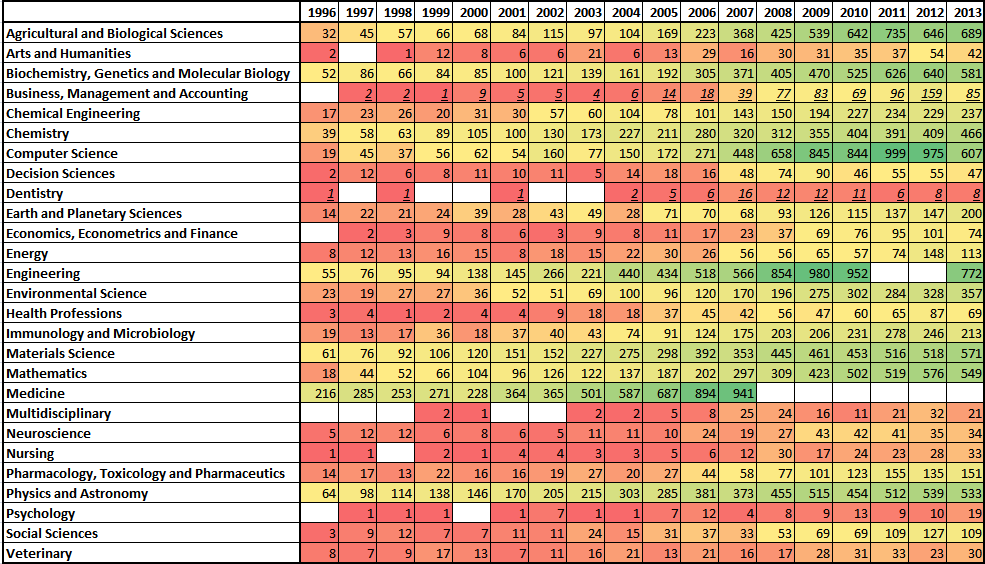In this Chart of the Week, we shed light on the metrics of scientific publications in Tunisia to understand its dynamics and trace its patterns. Tunisia ranks 59th worldwide with 44,798 scientific publications. Many international organizations have developed ranking systems such as the H-index, which takes into account factors like publications per capita, citable vs. non-citable effects, and more.
While our goal is not to address the philosophical importance of scientific publications nationwide, it's worth noting that, on an individual level, publications offer an effective strategy for increasing visibility and can certainly provide a strong competitive advantage in both national and international job markets. In fact, many leading companies have discovered potential recruits through scientific publications or conferences.
The heat map below outlines the number of publications in various fields from 1996 to 2013. In the map, red indicates a number of publications lower than the average of the total entries in our database, while green signifies better-than-average numbers. One notable observation is the nearly doubled number of publications in the energy sector after 2010, coinciding with the Tunisian revolution. Similarly, there appears to be a significant increase in publications related to business and management, possibly indicating a growing interest in entrepreneurship.
Tunisians demonstrate increased activity in scientific publications, particularly in disciplines such as mathematics, medicine, engineering, computer science, AI, and agriculture. However, there are three areas where Tunisians are not making the necessary effort to publish: veterinary studies, nursing, and dentistry. The lack of veterinary publications raises concerns, as many leading pharmaceutical companies conduct trials on animals before humans, often leading to medical breakthroughs. The reason for the low number of publications in dentistry remains unclear and may be attributed to classification issues.
Few of the problems that may impede greater publication contribution are as follows:
-
Access: Access to international publications and databases. Very often, even leading universities struggle with database subscription costs. For instance, Harvard University recently issued an open letter/warning stating that access to scientific journals costs them approximately $3.5M a year [1].
-
Language: While Tunisians are familiar with Romance languages, often, an observation is made that many students still struggle when writing in English. The impact of English on the number of publications is a topic of another research.
-
Resources: Lack of resources and access to experimental setups. The topic of insufficient public and private R&D spending in Tunisia has been discussed in one of our previous publications [2].
-
Motivation: Lack of academic and financial incentives.
-
Mentorship: This is where the problem lies. Anecdotally, many researchers and/or academic supervisors treat their students' publications as a lower-level priority activity and take exaggerated time to assist students with feedback and orientation.
-
Web Access: Slow and Intermittent.
Refrences:
1) https://www.theguardian.com/science/2012/apr/24/harvard-university-journal-publishers-prices
2) https://www.tuness.org/publications/chart-of-the-week/r-d-spending-tunisia
4) https://www.bibliotheque.nat.tn/
5) https://www.cnudst.rnrt.tn/
data source:

